Table of Contents
Today, the automotive industry is going through a rapid digital transformation. According to Market Research, the automotive cloud market is expected to grow from $32.8 billion in 2024 to $89.0 billion by 2032. This is driven by the growing number of connected vehicles, increased customer expectations towards better personalization, and the need for better management of operations processes. Because of these factors, more and more automotive companies are turning to cloud platforms. One such leading solution is Automotive Cloud by Salesforce, designed to optimize all automotive operations.
In this article, we’ll explore what Salesforce Automotive Cloud is, its core capabilities and benefits and what impact it can have on the industry in the near future.
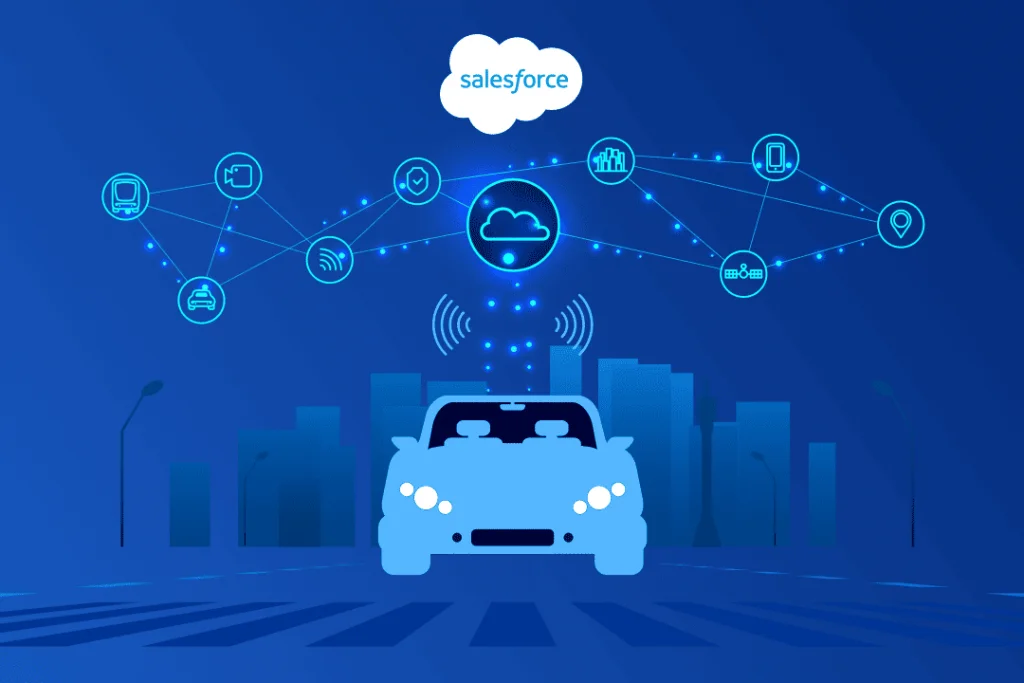
Automotive industry: the statistics
Continuing our discussion about the evolution of the automotive industry, one of its main problems today is a significant gap between customer expectations and the reality of what the industry is offering. According to the Salesforce research:
- 50% of automotive companies are investing in activating first-party data to improve customer experience;
- 73% of customers expect personalized experiences from automotive companies;
- 78% of automotive companies cannot customize customer communications.
So, what is stopping the industry from improving its operations? The answer lies in the usage of outdated systems and technologies, data silos, and limited access to real-time insights. It all prevents companies from taking advantage of the data at their disposal. To bridge this gap, automotive companies must invest in innovative tech solutions in their field. This is why Salesforce Automotive Cloud is flourishing today.
What is Salesforce Automotive Cloud?
Salesforce introduced its Automotive Cloud on 13 October 2022. It is a cloud-based customer relationship management (CRM) system designed for original equipment manufacturers (OEMs), car dealers, and suppliers to improve their automotive operations. Built on existing Salesforce platforms, like Sales and Service Cloud, it is used to track and manage customer and vehicle lifecycles to provide an exceptional customer experience at every touchpoint, from purchase to post-sale service.
The platform comes with a lot of features that allow automotive businesses to not only deliver connected and personalized customer experience but also to optimize all their operations through real-time analytics. Since its launch, various companies have been using Automotive Cloud. For example, Ford is leveraging this platform to enhance fleet management and reduce operational costs. General Motors has leveraged the Auto Cloud to enhance its auto lending and leasing operations based on customer credit histories.
But, managing such a CRM solution can be tricky. To benefit from Salesforce solutions, turn to SoftTeco’s Salesforce professional services. Being a Salesforce Consulting Partner, we offer expert guidance to help you fully leverage Salesforce CRM and tailor it to your needs. Our team can assist you in implementing best practices, optimizing workflows, and integrating needed functionalities to ensure your business is well-prepared to thrive in the automotive market.
How does Automotive Cloud function?
At its core, Salesforce Auto Cloud leverages Driver 360, a system specifically designed for the automotive industry. This platform combines a Driver Console, a Vehicle Console, advanced AI and strong analytical capabilities to provide a comprehensive view of both vehicle and customer lifecycles. With AI and analytics, businesses can predict customer trends, provide insights into vehicle maintenance, and deliver automated, branded experiences, such as real-time updates on vehicle order status.
Also, the Automotive cloud relies on Customer 360 (a broader platform for all industries). It serves as a single platform that aggregates customer data from various Salesforce applications like Sales Cloud, Marketing Cloud, and Service Cloud and helps create customer profiles that are accessible to everyone within the organization. This helps companies get a holistic view of their customers and maintain personalized interactions, break down data silos, and ultimately drive revenue by connecting through every touchpoint. Driver 360 extends the capabilities of Customer 360 by adding the features and analytics the companies need to work with cars and drivers.
Despite these capabilities, the Automotive Cloud comes with other notable features. But before we move to them, let’s consider what data it manages.
The data model of the Automotive Cloud
To help businesses create personalized interactions with customers, regardless of whether they engage online or in person, the Automotive Cloud uses a unified data model that brings together Customer 360°, Dealer 360°, Vehicle 360°, and Financial 360° solutions. In this way, the cloud collects the following types of data:
- Vehicles: information about vehicles throughout their lifecycle (model year, features, warranty, and service plans), from initial production to sale, for better control over the entire process;
- Customers: data about their purchase history, contact info, service history, and personal accounts. The availability of this data helps dealerships better manage interactions and build trust-based relationships with current and potential customers;
- Stakeholders: data about stakeholders involved in the automotive sales process, such as dealerships, manufacturers, and suppliers, for better coordination between all parties;
- Financial relationships: data about all automotive processes, like loans and leases, transactions, charges, fees, quotes, and warranties, for precise control over pricing and financial operations.
Key features of Salesforce Automotive Cloud
Returning to the features of the Automotive Cloud, let’s consider the most important ones and how they work:
Driver Console
The Driver Console collects all customer data about their interactions through continuous touchpoints (car browsing, purchase history) and customized alerts and sorts them automatically in one place. This allows dealers and manufacturers to easily analyze these insights and create a better customer journey.
If companies mix this feature with Household Management, they will be able to create a holistic picture of a vehicle owner’s household and past interactions with suppliers. This allows for even better personalization of support, offers, and sales.
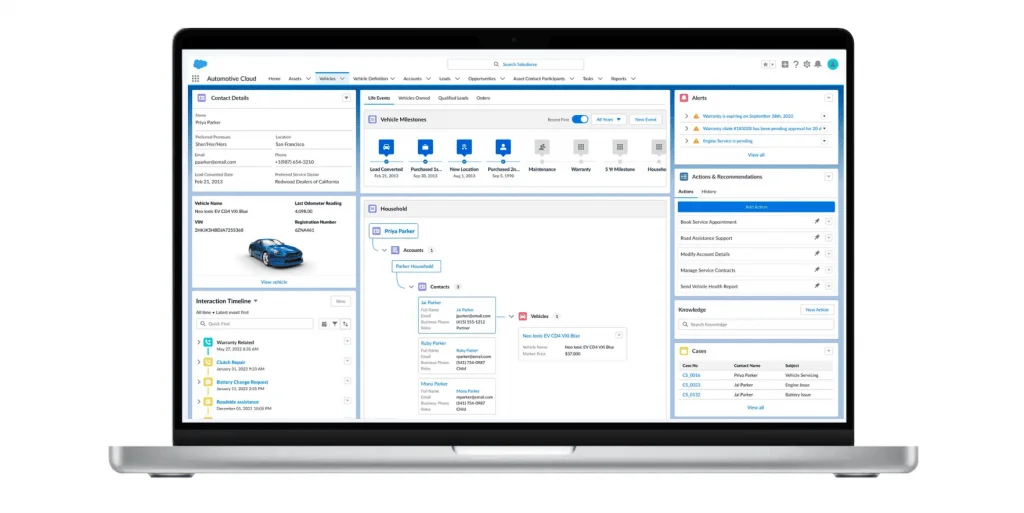
Source: Salesforce
Vehicle Console
The feature gives businesses a complete overview of all vehicle lifecycle data, such as its maintenance history, warranties, vehicle market value, and delivery reports. As a result, it helps companies track and manage vehicles efficiently throughout their lifecycle, respond quickly to customer queries, and improve overall fleet management.
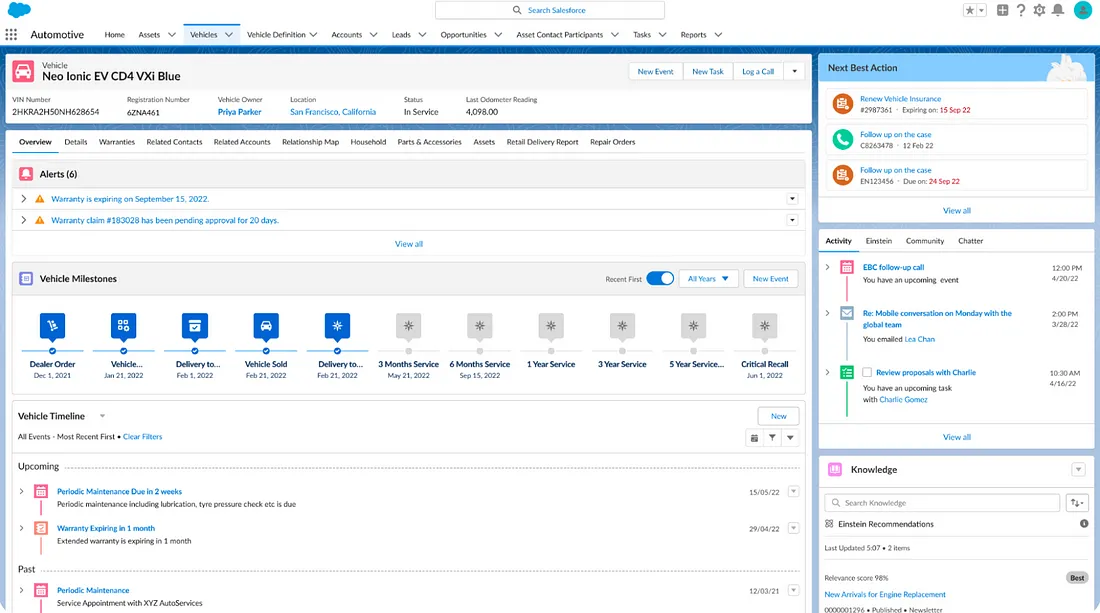
Source: Salesforce
Automotive Data Foundation
First of all, the feature builds on the industry standard called STAR (Standards for Technology in Automotive Retail) and serves as the backbone of the Automotive Cloud. It supports flexible, secure data processing and sharing with partners, ensuring compliance with global regulations. Also, it facilitates integration with other specialized tools and platforms in the automotive industry, such as Dealer Management Systems (DMS) or Inventory Management.
Automotive Lead Management
When it comes to lead management, the Automotive Cloud goes a few steps further than just the Salesforce Sales Cloud. The feature was specially designed to foster collaboration between dealers and automakers by providing them with more detailed customer and vehicle information, such as customer preferences, preferred seller, and brand of interest. This allows them to send the most valuable leads directly to the customer’s preferred dealership and close more deals efficiently.
Dealer Performance Management
The feature improves tracking and analysis of the dealerships performance. By accessing real-time data on dealership activities, original equipment manufacturers (OEMs) can adjust their strategies to maximize sales potential and ensure cohesive regional performance.
For example, dealers can report vehicle sales through retail delivery reports and submit proof-of-sales for parts and accessories. OEMs, in turn, can use that information for rebate calculations and analytics of dealers’ performance. OEMs and dealers can also use CRM Analytics dashboards to show actionable insights on dealer performance, sales lifecycle, revenue trends, and many more.
Analytics for Automotive
The Analytics for Automotive feature comes with purpose-built dashboards that allow dealers and automakers to analyze the company’s performance based on sales life-cycle, revenue, inventory, and more. This feature helps companies get a clear view of:
- Dealer performance: these dashboards give insights into the company’s performance to analyze sales trends, region-wise revenue trends, leads, and inventory management;
- OEM performance and sales: this dashboard provides essential metrics and projections for sales analysis, inventory management, and OEM performance tracking. Also, it includes embedded analytics for monitoring sales performance;
- Leads intelligence: you can use it to analyze lead conversion rates, identify high-value leads, and prioritize conversion efforts;
- Vehicle portfolio insights: gain an overview of the vehicle portfolio, including information on warranty expirations, work orders, and recalls, to ensure timely action.
These dashboards become available when you create an app with the Analytics for Automotive template in the CRM Analytics Studio (a platform for building data visualizations and reports). By selecting this template, users can access pre-configured dashboards tailored to the automotive sector, thus eliminating the need to build them from scratch.
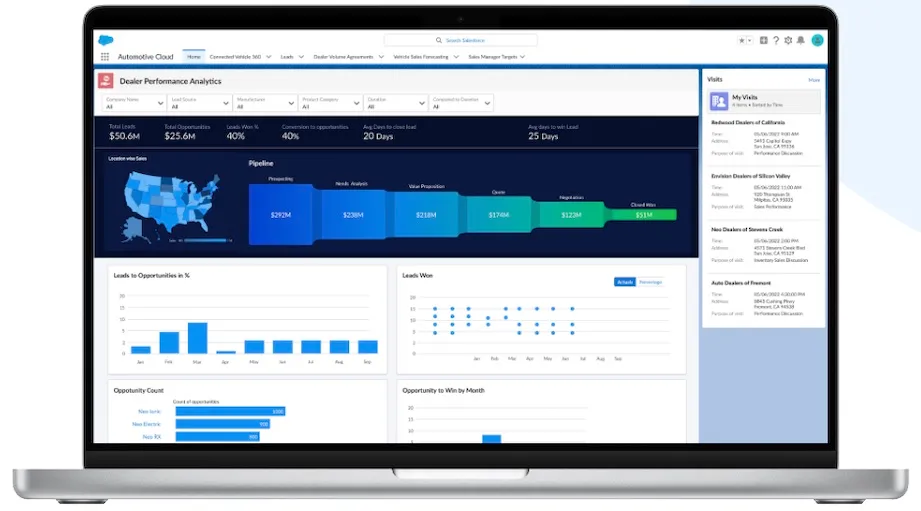
Source: Salesforce
Experience Cloud for Partners and Customers
Experience Cloud site is a platform used to manage partner relationships. Powered by Salesforce and Lightning, the site helps you and your partners work together to generate sales. By inviting partners to a site, a company can share its CRM data with them to improve sales and marketing. For example, the company can share leads with partners, allow them to register deals, and gain visibility into sales activity early on. Also, you can manage your channel sales with programs, business plans, and partner scorecards or provide training and certifications for your partners.
Warranty Lifecycle Management
The feature helps automotive companies manage their entire warranty vehicles and associated components with them with ease and flexibility. This includes capturing warranty claims from distributors and partners, managing the return process for service parts, and automating the warranty adjudication process (and many others).

Source: Salesforce
Benefits of Salesforce Automotive Cloud
Now, let’s look at the core benefits of Automotive Cloud adoption for businesses and their customers alike:
Improved customer experience
With this CRM platform, businesses can deliver personalized customer experiences through a 360-degree view of customer interactions. This allows companies to better identify customer needs, provide timely communications, and create a more connected journey across all touchpoints. Such personalized service helps automotive businesses build long-term and trusting relationships with their customers.
Improved sales process
Automotive Cloud provides a unified view of customer preferences and vehicle data through Driver 360. It allows companies to gain access to customer profiles and purchase histories, which helps them tailor their effort and offer personalized recommendations. By automating workflows, companies also can track leads, manage follow-ups, and close deals faster, which ultimately enhances conversion rates.
Proactive maintenance and service
The integration of vehicle data and AI-driven insights enables businesses to streamline customer service operations. Companies can proactively notify customers and service teams about upcoming service needs, maintenance schedules, or recalls. It reduces downtime for customers and strengthens trust in the brand’s reliability.
Efficient inventory and dealership management
The platform effectively oversees daily dealership activities, from test drives and car sales to repairs and after-sales services. It ensures efficient information sharing between dealership networks and their partners for better sales strategies. Also, dealers can track vehicle availability, monitor stock levels, and optimize their supply chain. With real-time data, they can quickly respond to demand changes and adjust inventory accordingly.
Scalability and integration
The platform seamlessly integrates with other Salesforce products, such as Marketing, Service, Sales Clouds, etc. This allows automotive businesses to expand their capabilities as they grow and makes it easier to incorporate new products into the system while still maintaining efficiency in client interactions.
Real-time automation
The platform comes with AI and analytics that allow businesses to analyze customer lifecycle, sales performance, and dealer metrics in real-time. This capability offers deep insights into client and vehicle data and overall automotive operations, and, based on them, businesses can make data-driven decisions promptly.
If these benefits of Automotive Cloud catch your eye and you have a question about its cost, let’s move on.
Pricing plans of Salesforce Automotive Cloud
Finally, let’s look at the available pricing plans of Automotive Cloud. While pricing can fluctuate based on customization and specific needs, the following plans are the most common:
- Enterprise: $325\month. It is suitable for both medium and large companies and has advanced customization and integration features.
- Unlimited Edition: $500\month. It is perfect for large organizations with extensive needs and offers unlimited access to all features, advanced analytics, and customer support.
- Einstein 1 for Service: $700\month. It is suited for businesses mainly looking to leverage artificial intelligence in their service operations.
For more information about pricing plans, additional features, add-ons, and support, you’ll need to contact the sales representative directly on the official Salesforce website.
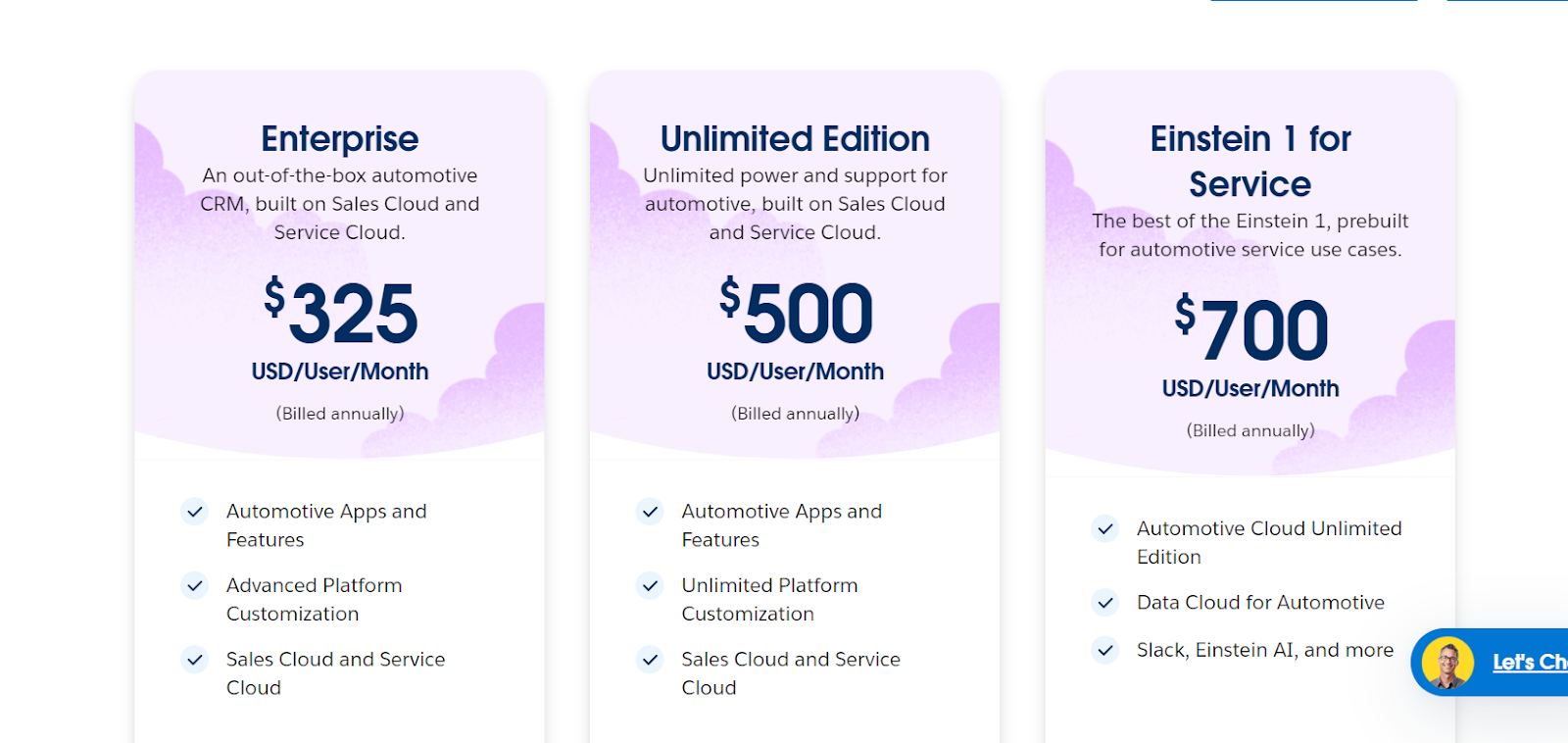
Source: Salesforce
The future of Salesforce Automotive Cloud: conclusion
Is Automotive Cloud a future-proof solution? Yes, because the CRM platform offers customer- and business-oriented features, integrations, advanced analytics, and AI – all necessary to meet the evolving needs of the automotive industry. Each was designed to address the pain points of customers while driving operations forward. As we look ahead, the relevance of the Automotive Cloud solution becomes even clearer.
According to McKinsey, 95% of all new vehicles sold by 2030 will be connected cars, an increase of 50% from 2021. As the number of connected cars rapidly increases, the demand for advanced data management and customer-centric services also will grow. It means that cloud providers, like Salesforce, will play a crucial role in helping automotive companies achieve this. The ability to leverage Salesforce Automotive Cloud to analyze a lot of customer and vehicle data will be vital for creating tailored services and maintaining a competitive advantage in the future.
Expert Opinion
Salesforce released the Automotive Cloud in response to several challenges that the automotive market struggled with. One major issue is that dealerships found it difficult to consolidate customer data from disparate systems. They could not deliver a personalized, omnichannel experience that meets consumer expectations for seamless online and offline interactions.
Second, sales processes were often complex and lengthy, requiring improved workflows between dealers and customers. Inventory management also required changes related to real-time tracking of inventory levels. So, dealerships needed better analytics to navigate all these processes. A unified solution was required that would optimize all processes, integrate well with needed systems, and be customized.
I suppose that the future of this platform is promising. The platform capabilities will expand, offering dealerships more predictive analytics and customers more personalization with the help of AI. It also will improve communication among automotive manufacturers and dealerships to deliver innovative automotive services.


Comments